马子山回民公墓服务站,南京,江苏,中国
2015-10-11建筑设计马晓东东南大学建筑设计研究院有限公司ArchitectsMAXiaodongSoutheastUniversityArchitecturalDesignInstituteCoLtd
建筑设计:马晓东/东南大学建筑设计研究院有限公司Architects: MA Xiaodong/Southeast University Architectural Design Institute Co., Ltd.
马子山回民公墓服务站,南京,江苏,中国
建筑设计:马晓东/东南大学建筑设计研究院有限公司
Architects: MA Xiaodong/Southeast University Architectural Design Institute Co., Ltd.
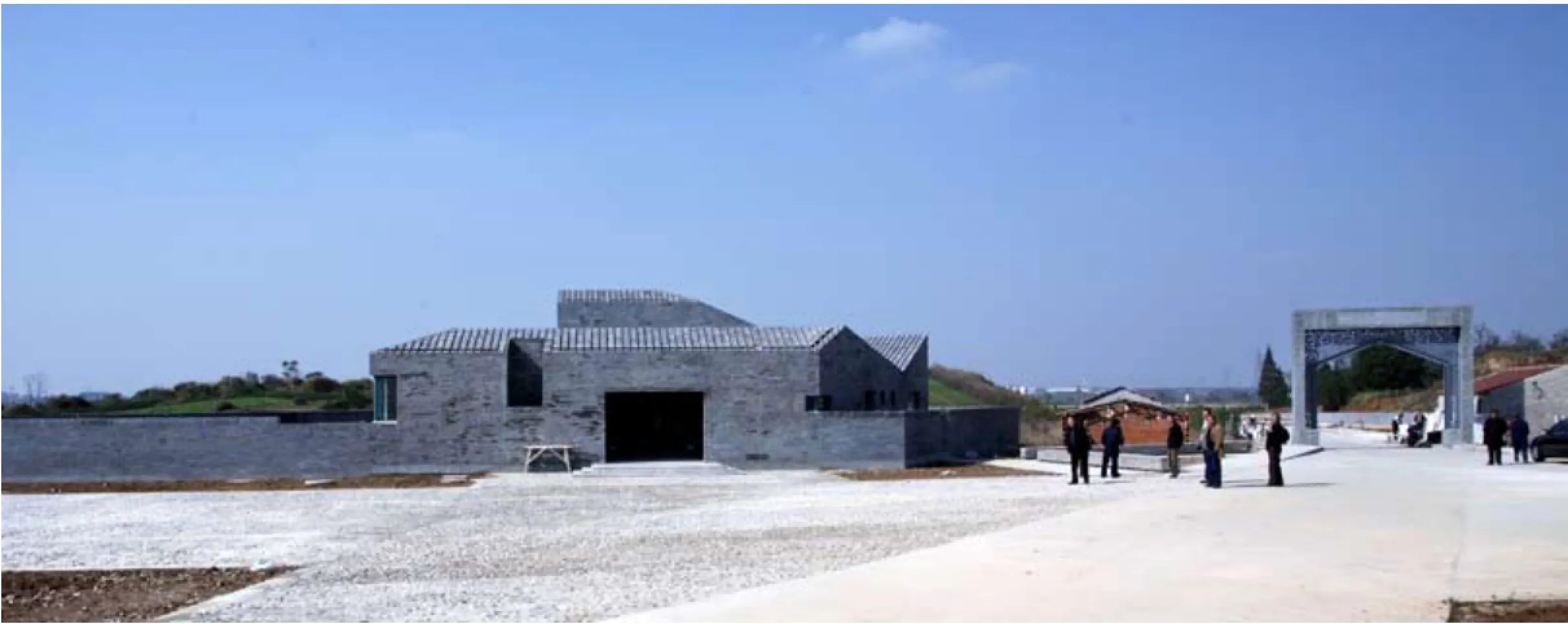
1 东侧全貌/Panoramic view from the east
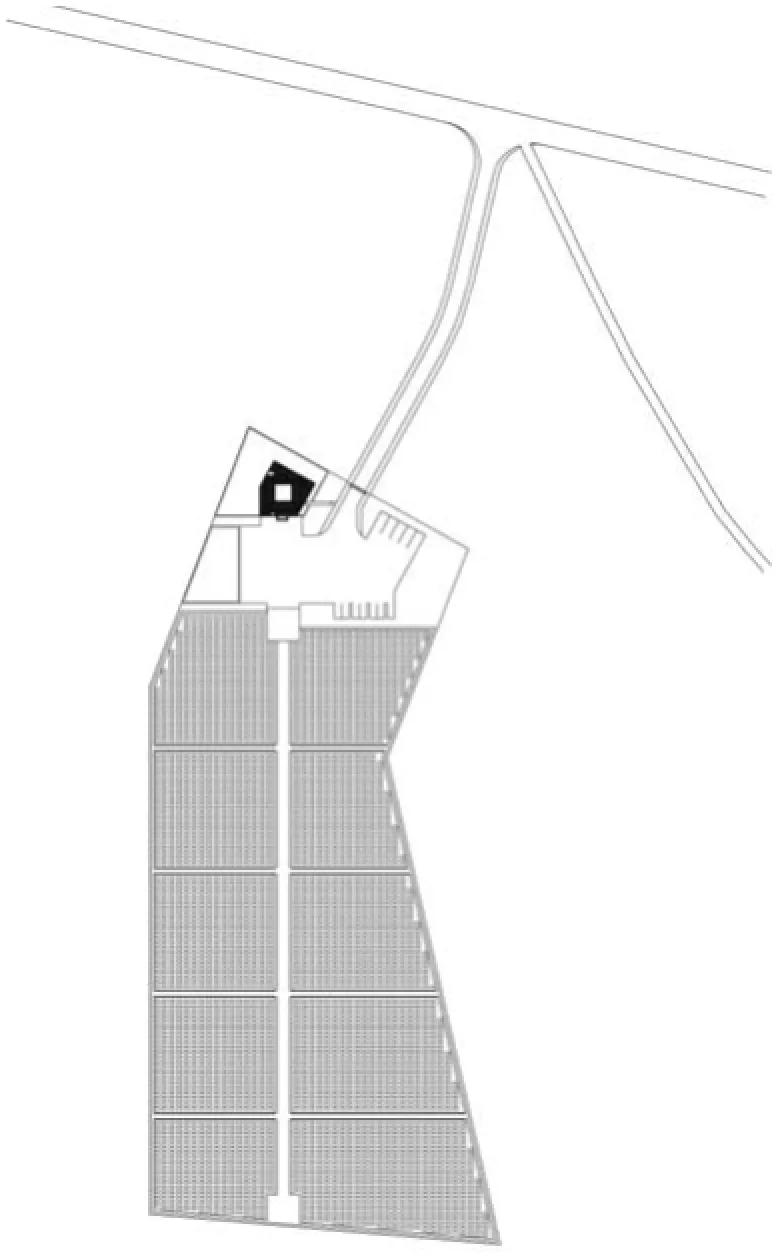
2 总平面/Site plan
回民公墓坐落在一个东西狭长的西向坡地上,墓区周边丘陵起伏,散布着农田、村舍和一片砖瓦厂。墓区大门设在墓区西端,通过引道连接乡间公路。墓区服务站房位于基地西侧坡底,主入口呈不均衡对称状呼应墓区东西向轴线。回族的丧葬礼俗有速葬、薄葬、土葬三个特点。依照伊斯兰教的教义,“安拉”用泥土造化了人的生命,又回归于泥土之中,然后再从泥土中复活。在古兰经的指引下,穆斯林葬礼崇尚简朴。这项设计旨在传达穆斯林平和的生死观,而非庄严宏大的纪念性。设计试图通过空间营造和材质处理表现出特定地域条件和文化背景下回民墓地的环境特质。
墓区服务站房的平面原型源于回族的“回”字,以契合公墓主人的民族与文化属性。“院落”也是江南传统建筑的核心元素。“回”字内院保持正南北向方位,而建筑外部形体顺应基地边界,扭转并与原正交边界叠合,形成五边形外廓。双坡屋面随正交与扭转方形的控制边线而起伏,由此产生随机变化的屋面轮廓。站房中心院落类似江南传统的四合院空间,周边还留有小天井与边缘小院,透出江南园林边角天井的空间意趣。东侧院墙与建筑外墙合为一体,并与其余三面院墙共同围合形成建筑外部院落空间。
薄片望砖曾是江南一带传统民居屋盖建造中铺设于木椽之上的通用材料,是传统粘土砖中的一种。粘土砖取自于土,由此契合了伊斯兰教义的生命观,并获得了与乡土景观天然和谐的品质。薄片望砖对建筑外墙面和屋面形成整体包裹,获得了这个小尺度建筑所需要的纯粹性。对应于墙面与屋面两种不同的界面属性,设计采用了不同的构造肌理:实墙面选择错缝贴面,避免望砖尺寸差异所带来的混乱。屋面通缝拼贴,每垄之间立砌一片望砖,产生出类似于瓦垄的光影效果。大面积窗洞口用清水望砖作格栅式砌筑,中心内院地面采用清水砖立铺,进一步强化了院落空间界面的材质一致性。
墓区大门混凝土门架仍以薄片望砖贴面,门架以内用H型钢构成伊斯兰尖券样式,尖券与框架间填充经过变形操作的古兰经文图案。图案用钢板制成,带有明显手工痕迹。钢构尖券和钢板图案表面施以伊斯兰文化的代表性绿色。类似的手法再现于内院轴线上的两个窗洞,其间填充的钢板几何花饰运用了伊斯兰典型图案。这两个窗洞与其他玻璃窗的差异性使服务站与室外墓区获得了恰当的空间联系。
中心内院周边的檐廊顶棚是唯一采用小木作的地方。人字形木格栅表面饰清漆,格栅内嵌入筒灯。清水木质的暖性特质恰当地起到抚慰人心的作用,同时也呈现出传统院落檐廊的意象。□
项目信息/Credits and Data
客户/Client: 南京市民族宗教事务局/Nanjing Municipal Bureau of Ethnic and Religious Affairs
位置/Location: 南京市江宁区湖熟镇新跃村马子山地块/Mazishan Block, Xinyue Village, Hushu Town, Jiangning District, Nanjing
设计单位/Design Company: 东南大学建筑设计研究院有限公司/Southeast University Architectural Design Institute Co., Ltd.
主持建筑师/Principal Architect: 马晓东/MA Xiaodong
设计团队/Design Team: 马晓东,顾燕,谭亮,赵谦/MA Xiaodong, GU Yan, TAN Liang, ZHAO Qian
场地面积/Site Area: 34,800m2
建筑面积/Floor Area: 320m2
材料/Materials: 钢筋混凝土,薄片望砖,钢板,H型钢/ Reinforced concrete, thin sheathing brick, steel plate, H-shaped steel
设计时间/Design Period: 2006.11-2007.11
建造时间/Construction Period: 2008.04-2008.11
摄影/Photos: 耿涛,马晓东/GENG Tao, MA Xiaodong
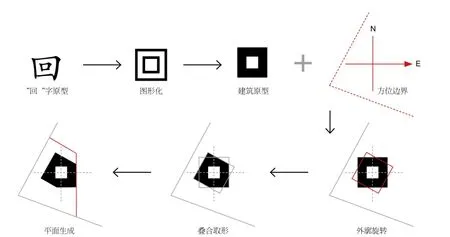
3 概念生成/Concept generation
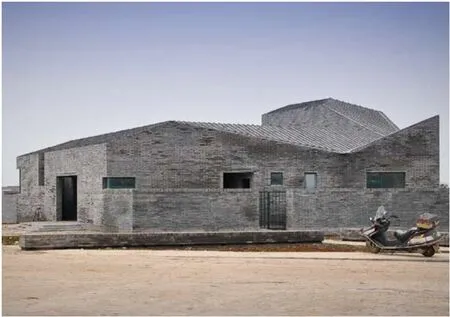
4 薄砖包裹形体/Form wrapped with bricks
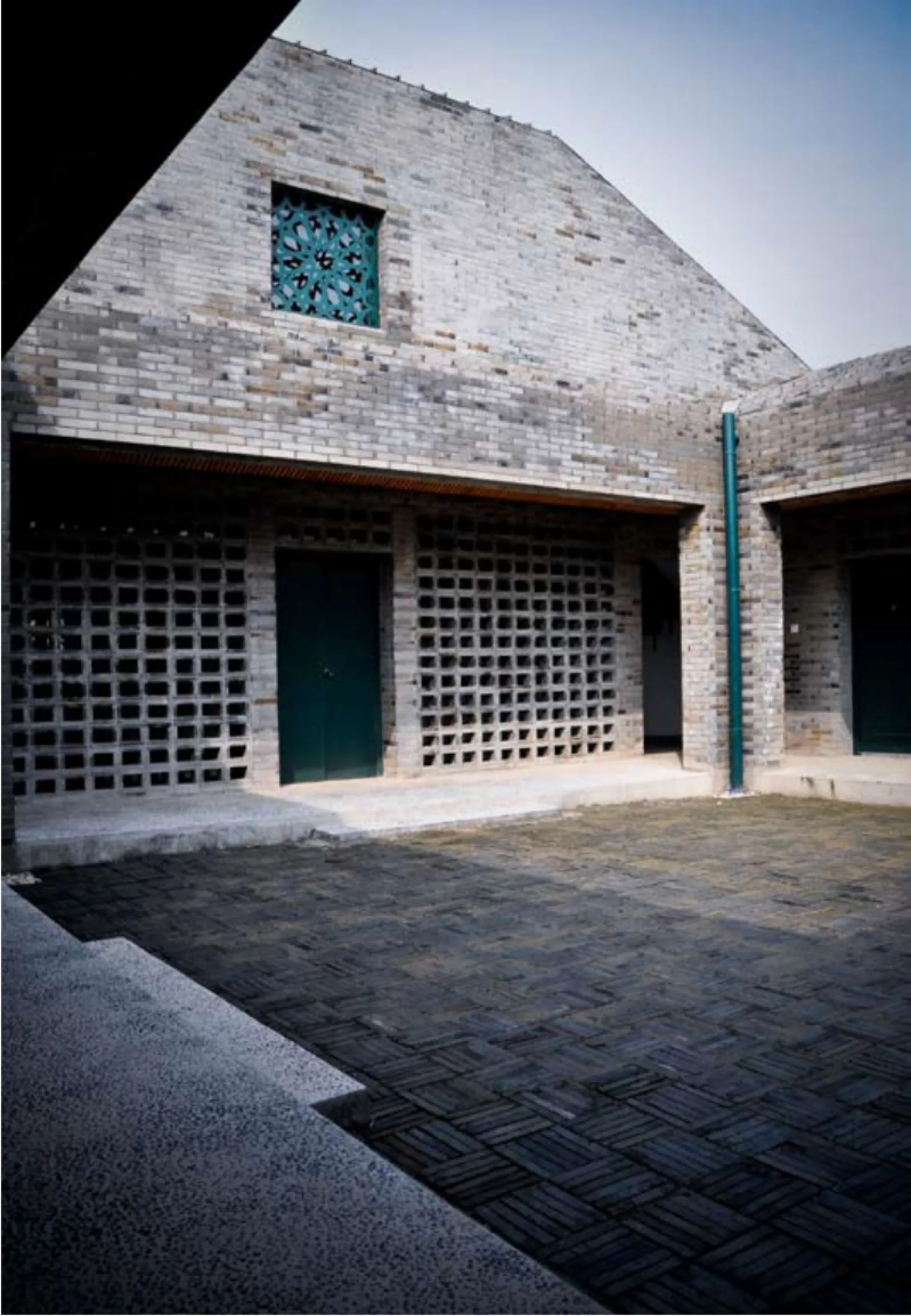
5 中心合院/Central courtyard
The Mazishan Muslim Cemetery is located on the west-facing slope in a narrow strip of land stretching east-west. It is surrounded by undulating hills dotted with farms, cottages and a brick plant. The cemetery gate is located at the western end of the complex, leading to the country road through a connector road. The service building of the cemetery is located at the bottom of the slope in the west of the project site, with an asymmetrical main entrance along the east-west axis. Muslim funeral rites have three characteristics which are quickness, simplicity and in-ground burial. In accordance with the Islamic doctrines, human life is created by “Allah” with earth, returns to the earth and then revives from the earth. Under the guidance of the Koran, Muslims uphold the simplicity of their funerals. This design is intended to convey a peaceful conception of life and death of Muslim, rather than solemnity and grandeur of commemoration. Through spatial arrangement and material usage, the design seeks to highlight the distinctive environment of Muslim Cemetery in its specific regional and cultural background.
The plan of the cemetery service building originated from the Chinese character of ethnic minority group of Hui, "回", to be in line with the ethnic and cultural attributes of the cemetery owners. “Courtyard” is the core element of traditional Chinese architecture to the south of Yangtze River. A"回"-shaped courtyard takes an absolute north-south orientation, while the exterior of the building twists to be in conformity with boundaries of the project site and overlaps with the original orthogonal shape to form a pentagonal outline. The double-slope roof has a changing profile coordinating with the edges of the orthogonal and twisted square shapes, creating random variations of the roof contour. The central courtyard of the building is similar to the traditional courtyards to the south of Yangtze River with small yards along the edges, revealing the spatial charm of corner yards in southern Chinese gardens. The east wall of the courtyard is jointed with the exterior walls of the building, together with walls on the other three sides, forming the courtyard space outside of the building.
Thin sheathing bricks are materials commonly used in southern traditional houses to be laid on top of the roof rafters, a kind of traditional clay bricks. Clay bricks are made of earth, thus complying with the doctrines of Islamic view of life, while achieving harmony with the local landscape. Thin sheathing bricks provide holistic coverage for the exterior walls and roofs of the building, exhibiting the purity needed in this small-scale building. Corresponding to the two different interface attributes of walls and roofs, the design requires different configuration textures: the solid walls are built with staggeredjoint veneer to avoid confusion caused by brick size differences. The roof bricks are laid with aligned joints with one row of sheathing bricks set vertically in between two rows, creating shadow effect similar to that of tile ridges. Large window openings are built with dry sheathing bricks in grille style,while the ground of the central courtyard is also paved with dry bricks, to further strengthen the material consistency of the spatial interfaces of the courtyard.
The concrete frame of the cemetery gate is also veneered with thin sheathing bricks. Inside the frame,H-shaped steel beams are used to constitute Islamicstyle pointed arch. Between the arch and the frame,patterns of transformed Koran doctrines are used to fill the space. The pattern is made of steel plates with obvious handcraft traces. The steel pointed arch and pattern plates are painted with green, representative color of Islamic culture. Similar approaches are adopted in two windows on the axis of the inner courtyard, where steel plates are made with the typical Islamic geometric floral patterns. The difference between these two windows and the other glass ones provides the proper spatial connection between the service building and the outdoor cemetery.
The surrounding verandas and sheds in the central courtyard are the only architectural elements built with wood. Surfaces of the "人"-shaped wood grille are painted with clear paint. Tube-lights are embedded in the grilles. The warmth of wood appropriately pacifies one's heart, expressing the image of traditional courtyard verandas.□
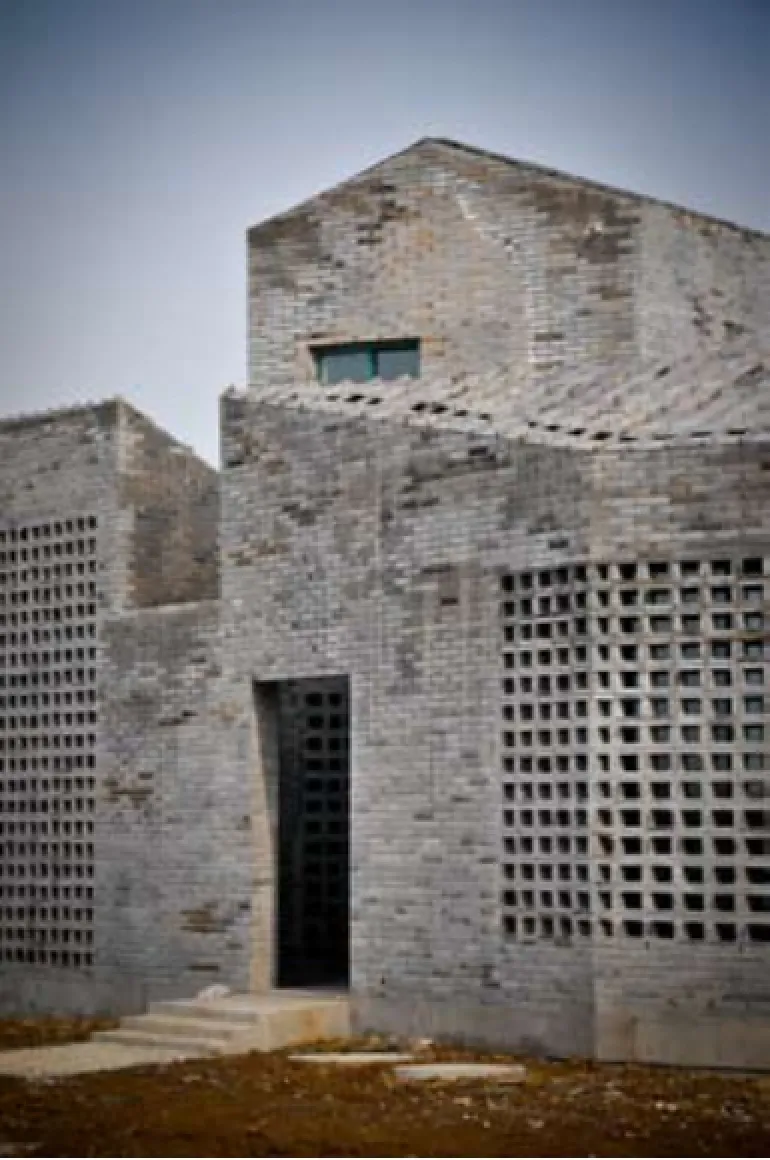
6 南侧局部/Partial view of south facade
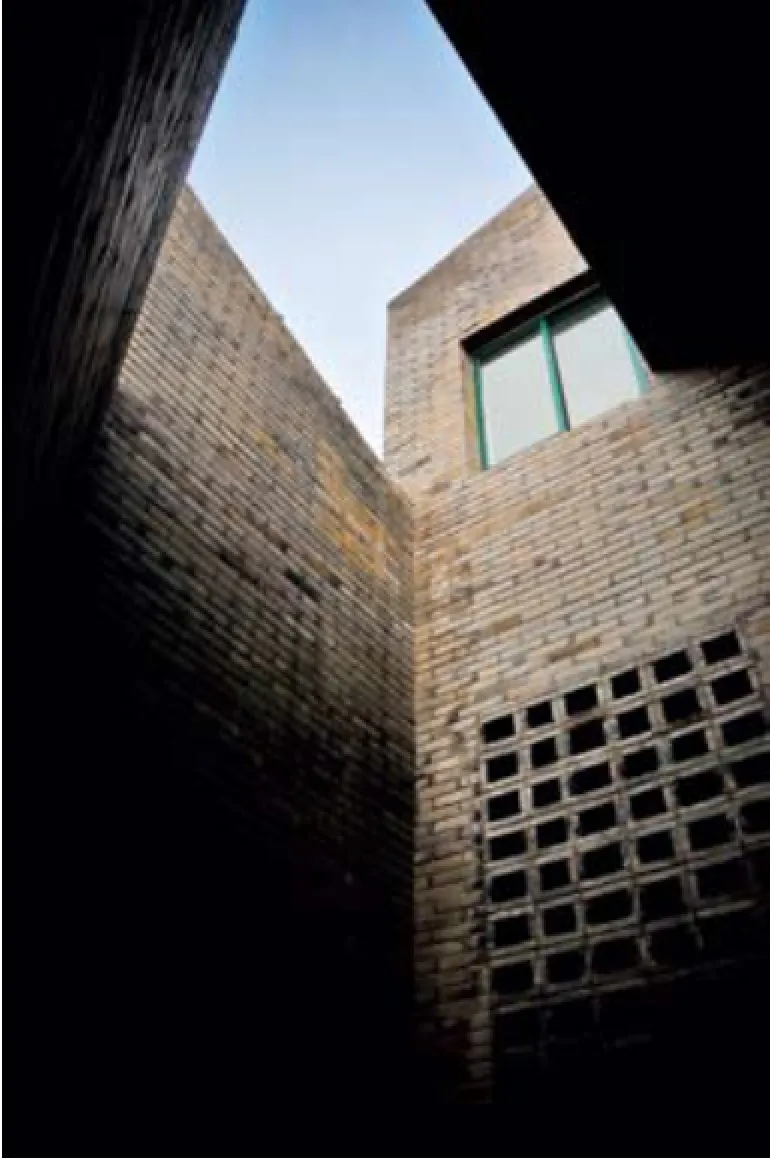
7 小天井/Courtyard

8 首层平面/Floor 0 plan

9 二层平面/Floor 1 plan
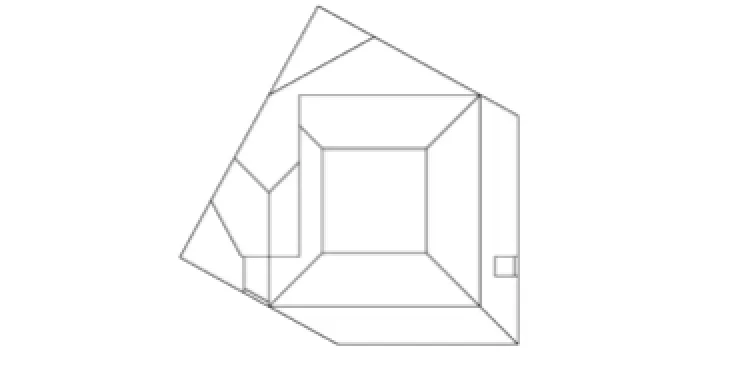
10 屋顶平面/Roof plan
评论
袁野:作为公墓的附属服务性建筑,建筑师对公墓服务站性格的恰当拿捏显得尤为重要——既要表达个性,又不能喧宾夺主;即要体现服务性特征,更要与公墓整体调性相协调。该设计显然做到了这一点。通过灰色薄片望砖对建筑形体的整体包覆完成了对宗教生死观的象征性表达,并通过局部点缀的民族图案作为清晰的符号,让这栋小房子很容易地被普通人读懂,从而达到文化上的认同。
中心院落空间和边角天井的设置及其适宜尺度、镂空的灰砖墙、檐廊的木格栅吊顶,以及坡屋顶竖砖形成的瓦垄意味等“陌生化”的处理手法成功地诠释了江南传统建筑的地域性文化特征,并赋予该建筑以朴素的人文气质。
周渐佳:这座小巧的公墓服务站背靠开阔的墓区,是进入整个区域的起点。项目的平面由“回”字抽象而来,一方面是从字到建筑的图示化转变,直白易懂;另一方面由此形成的建筑格局与江南典型的院落平面自然地形成呼应。历史上数次的迁徙使来自西域的回民族最终扎根江南,南京因此有着悠久的回民聚居历史。项目中对粘土砖的使用以及对各种砌法的实验充满着质朴感,也存在着某种建筑材料上不分地域的通属性,似乎是对远方遥遥的应答。这些空间上、细节上的考虑贯穿了整座小建筑,也让我们看到宗教建筑在使用符号表征自己以外的其他诸种可能。

11 窗细部/Window detail

12 剖面/Sections
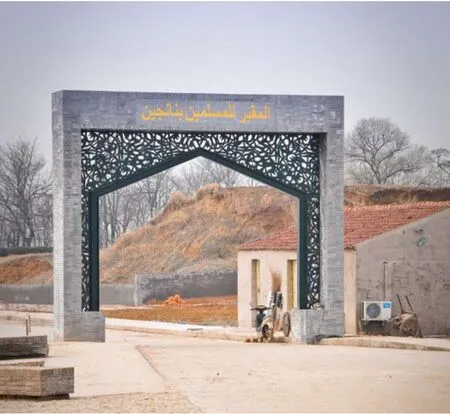
13 公墓大门/Cemetery gate
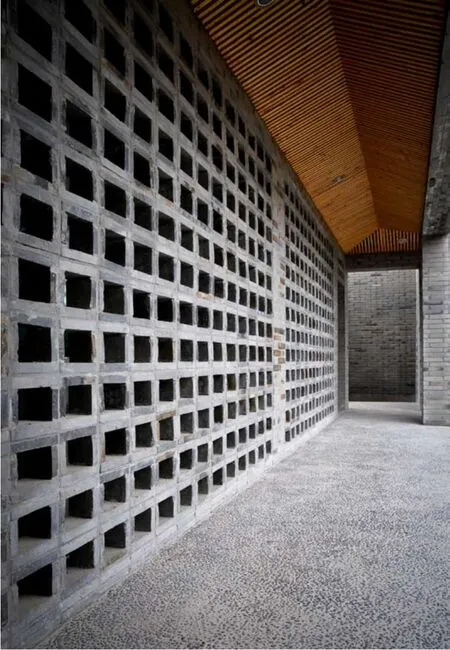
14 合院回廊/Courtyard cloister
Comments
YUAN Ye: Service buildings act as affiliated structures to a cemetery. It is very important for architects to determine the appropriate character of these building types. Service buildings should not overwhelm and should reflect the character of its function. They may express some individuality in proper coordination with the overall cemetery ensemble. This building acheives these guidelines. Sheathing tiles clad the whole building, expressing the symbology of the religious concept of life and death. The ethnic pattern on its surface is a clear symbol that ensures that this small building can easily be read, so as to achieve cultural recognition.
The suitable scale of the central courtyard space and the corner patios, and the treatments on the hollow gray brick wall, wooden veranda ceiling grilles,and vertical tiles on the sloping roof form represent tactics of "defamiliarization". These tactics successfully explain the traditional Southern regional architectural characteristics, and give the building a simple humanistic temperament.
ZHOU Jianjia: Resting within an open graveyard,this exquisite reception pavilion serves as the primary entry of the entire cemetery complex. The plan of this project was generated from the Chinese character"回", representing the Hui Nationality, an ethnicity of Chinese Muslims. On one hand, this building is an easy to understand transformation from character to architecture; on the other hand, the character also echoes the layout of typical Jiangnan courtyard home. After multiple migrations over the centuries, the Hui,a ethnicity of Central Asian ancestry, firmly established an indigenous community in the Jiangnan area, and therefore Nanjing has a long history of Hui ethnicity settlement. Surfaced with unadorned clay bricks of varied courses, the pavilion is an experiment of an austere quality which expresses the universal characteristic of clay, but also evokes a response to faraway distance. Other meditations on space and detailing are used on this tiny pavilion, unfolding before us in a sacred space which takes an alternative design approach rather than utilizing a symbolic representation.
Service Building of Mazishan Muslim Cemetery, Nanjing, Jiangsu, China, 2008
